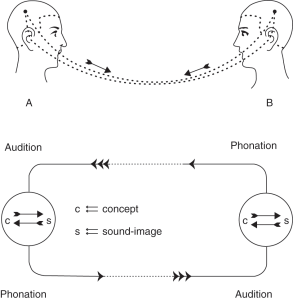1 Chapter 1 – Learning the CODEC
Cracking the CODEC
CODEC: Code and decode.
MODEM: Modulate and demodulate.
I/O: Input and output.
Write and read.
Speak and listen.
Get it?
There are parts of our brains that manage the coding and decoding of language. No single part of the brain does that, but together–and in the various ways we receive and use language–these parts of our brain act together to make meaning.
Consider this classic illustration from Ferdinand de Saussure’s linguistics text, Course in General Linguistics.
Here’s how understanding Saussure’s semiotic ideas can supercharge your college reading and writing skills:
**Reading: Decoding Beyond the Surface**
* **Critical Thinking:** Saussure reminds you that language is a system of signs, not a direct reflection of reality. Words don’t inherently carry meaning – it’s a social agreement. This awareness helps you become a critical reader. You can question the author’s choice of words and consider the cultural context that shapes their meaning.
* **Multiple Meanings:** Remember the signifier/signified split? A single word can have multiple signifieds depending on context. Understanding this empowers you to analyze texts for layers of meaning, not just the surface level.
* **Author’s Intent vs. Reader’s Interpretation:** Saussure highlights the gap between what an author intends and what a reader interprets. This is crucial! You can analyze how the author uses language to shape your understanding and consider how your own background might influence how you interpret the text.
**Writing: Encoding with Clarity**
* **Precise Communication:** Academic writing thrives on clear communication. Knowing that meaning is constructed, not inherent, makes you a more careful writer. You choose words with precise signifieds (meanings) relevant to your field.
* **Tailoring Your Message:** Saussure reminds us that the signified (meaning) you intend might not be the one your reader gets. So, you become mindful of your audience. You use language that aligns with their expectations, avoiding jargon that might leave them confused.
* **Beyond Literal Meaning:** Saussure paves the way for understanding figurative language like metaphors and symbolism. You can use these tools strategically to add depth and nuance to your writing, making your arguments more impactful.
In essence, Saussure’s semiotics equips you with a decoder ring for unlocking the complexities of language. You become a more critical reader, able to analyze texts with a discerning eye. As a writer, you gain the power to communicate precisely and tailor your message for maximum impact on your academic audience. So, the next time you pick up a textbook or write an essay, remember Saussure – he might just be the secret weapon you need to ace your college courses!
- "Phonation" is speaking; "audition" is listening. I'm sure you can guess what the writing equivalents are. ↵


